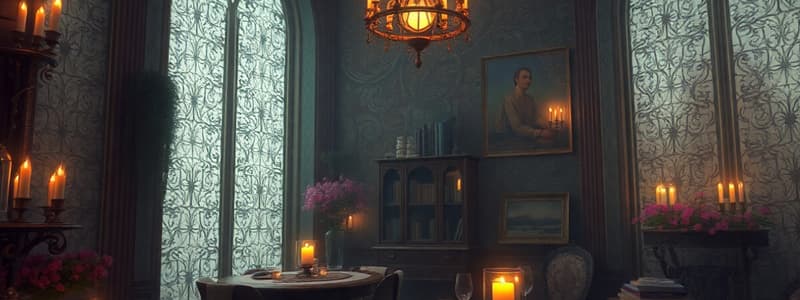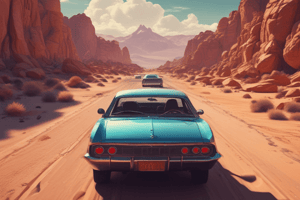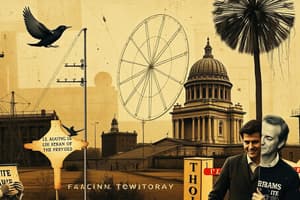Podcast
Questions and Answers
What is the production designer's main responsibility?
What is the production designer's main responsibility?
- Directing the actors' performances.
- Managing the film's marketing campaign.
- Securing funding for the film.
- Overseeing the film's visual look. (correct)
How does production design enhance storytelling?
How does production design enhance storytelling?
- By providing visual cues about the story. (correct)
- By handling the catering on set.
- By writing the film's screenplay.
- By choosing the filming locations.
Which film is an example of significant production design enhancing the narrative?
Which film is an example of significant production design enhancing the narrative?
- Blade Runner (correct)
- Forrest Gump
- The Sound of Music
- Toy Story
What is a mood board in production design?
What is a mood board in production design?
Which element helps establish a film's mood and atmosphere?
Which element helps establish a film's mood and atmosphere?
What is the purpose of color theory in production design?
What is the purpose of color theory in production design?
Who was a pioneer in production design during Hollywood's Golden Age?
Who was a pioneer in production design during Hollywood's Golden Age?
What kind of aesthetics are typical in science fiction production design?
What kind of aesthetics are typical in science fiction production design?
With whom does the production designer collaborate to establish the visual style?
With whom does the production designer collaborate to establish the visual style?
Why is good communication important in the production design process?
Why is good communication important in the production design process?
Which film uses production design to highlight class differences?
Which film uses production design to highlight class differences?
What does the spinning top represent in Inception?
What does the spinning top represent in Inception?
What is a key factor to consider when choosing a filming location?
What is a key factor to consider when choosing a filming location?
What should be included when creating a mood board?
What should be included when creating a mood board?
What is the first step in designing a set?
What is the first step in designing a set?
What kind of materials should be selected for a modern set?
What kind of materials should be selected for a modern set?
Which department should you work with to ensure proper lighting in your set?
Which department should you work with to ensure proper lighting in your set?
What is an important detail to pay attention to when building a set?
What is an important detail to pay attention to when building a set?
What should be done after the set has been built and dressed?
What should be done after the set has been built and dressed?
What is the goal of set design?
What is the goal of set design?
Flashcards
Production Designer
Production Designer
Responsible for the film's overall visual aesthetic, including sets, locations, props, and costumes, ensuring authenticity and immersion.
Production Design Contribution
Production Design Contribution
Production design establishes the setting, time, mood, and themes, enhancing character development and plot progression through visual cues.
Mood Board
Mood Board
A visual collage of images, textures, and colors that communicates the aesthetic direction of a film to the team.
Key Elements
Key Elements
Signup and view all the flashcards
Color Theory Role
Color Theory Role
Signup and view all the flashcards
Genre Differences
Genre Differences
Signup and view all the flashcards
Scene Analysis
Scene Analysis
Signup and view all the flashcards
Props and Costumes in Storytelling
Props and Costumes in Storytelling
Signup and view all the flashcards
Location Scouting
Location Scouting
Signup and view all the flashcards
Mood Board Creation
Mood Board Creation
Signup and view all the flashcards
Set Design Process
Set Design Process
Signup and view all the flashcards
Study Notes
- Production designers are responsible for a film's visual aesthetic.
- They design and supervise sets, locations, props, and costumes.
- All of which align with the director's vision.
- This ensures the film's world is authentic and immersive.
Storytelling
- Production design establishes the setting, time period, mood, and themes.
- Visual cues enhance character development and plot progression.
Blade Runner (1982)
- A prime example with neo-noir, cyberpunk design, filled with skyscrapers and neon.
- Perpetual rain creates a dystopian atmosphere.
- The film reflects themes of identity, technology, and existentialism.
- Detailed world-building enhances philosophical undertones.
Mood Boards
- Mood boards are visual collages that communicate a film's aesthetic direction.
- Production designers use these to convey the look and feel of the sets, costumes, and props.
Key Elements
- Set design is the physical space where scenes take place.
- Props enhance realism and character interaction.
- Color palette influences emotional tone.
- Lighting affects mood, with warm lighting for intimacy, harsh lighting for tension.
- Textures and materials create depth and realism, like aged wood for historical films.
Color Theory
- Utilized to evoke emotions and reinforce themes.
- The Grand Budapest Hotel (2014): Uses pastel colors for a whimsical, nostalgic tone.
- Schindler’s List (1993): Mostly black-and-white, with a symbolically significant red coat.
- Joker (2019): Shifts from dull colors to vibrant hues.
Historical Evolution
- Early silent films used theatrical sets.
- German Expressionism (Metropolis, The Cabinet of Dr. Caligari) used exaggerated, surreal designs.
- Hollywood’s Golden Age (Gone with the Wind) featured lavish sets.
- Pioneers include Cedric Gibbons (The Wizard of Oz), William Cameron Menzies (Gone with the Wind), and Ken Adam (James Bond films).
Genre Differences
- Science fiction: Features futuristic sets, advanced technology, and sleek or dystopian aesthetics (Blade Runner 2049).
- Fantasy: Imaginative, otherworldly environments with elaborate set pieces (The Lord of the Rings).
- Historical drama: Authentic period-accurate details in architecture, props, and costumes (1917).
Key Responsibilities
- Working with the director to establish visual style.
- Coordinating with art directors, set designers, and prop masters on sets.
- Consulting costume designers to ensure alignment with the setting.
- Collaborating with cinematographers to match lighting and color schemes.
Communication
- Critical for aligning every department with the film’s vision.
- Poor communication can result in inconsistencies, budget issues, and delays.
Parasite (2019)
- Contrast between the Park family's modern house and the Kim family’s cramped basement reinforces class disparity.
- Sleek design symbolizes wealth, while the cluttered residence reflects struggle.
Props and Costumes
- Props: Inception's spinning top serves as a metaphor for reality.
- Costumes: Joker's suit becomes more vibrant, symbolizing psychological shift.
Location Scouting
- Essential for authenticity, logistics, and budget.
- Considerations: story relevance, accessibility, natural lighting, and cost.
Creating Mood Boards
- Involves gathering references, defining color schemes, and including material samples.
- Mood boards help unify the film’s aesthetic vision.
Designing a Set
- Step 1: Understand the story and identify key themes.
- Step 2: Research historical, cultural, and architectural references and create mood board.
- Step 3: Sketch layouts to determine spatial relationships.
- Step 4: Select materials, like wood for a rustic setting or steel for modern, consider aging.
- Step 5: Collaborate with cinematographers for proper lighting and costume designers for color harmony.
- Step 6: Construct structures, add props, and pay attention to details like weathering and color coordination.
- Step 7: Adjust elements based on camera framing and ensure alignment with the film’s tone.
- This process ensures the production design effectively enhances storytelling and immerses the audience.
Studying That Suits You
Use AI to generate personalized quizzes and flashcards to suit your learning preferences.



